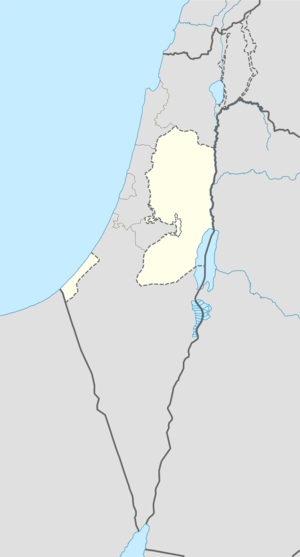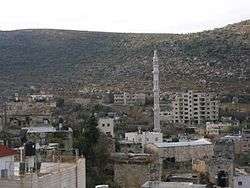Ein 'Arik
| Ein 'Arik | |
|---|---|
| Other transcription(s) | |
| • Arabic | عين عريك |
|
Ein 'Arik | |
 Ein 'Arik Location of Ein 'Arik within the Palestinian territories | |
| Coordinates: 31°54′24″N 35°08′35″E / 31.90667°N 35.14306°ECoordinates: 31°54′24″N 35°08′35″E / 31.90667°N 35.14306°E | |
| Palestine grid | 163/145 |
| Governorate | Ramallah & al-Bireh |
| Government | |
| • Type | Village council |
| Population (2007) | |
| • Jurisdiction | 1,567 |
| Name meaning | "Spring of the compactly-built one"[1] |
Ein 'Arik (Arabic: عين عريك) is a Palestinian town in the Ramallah and al-Bireh Governorate, located 7 kilometers west of Ramallah in the northern West Bank. According to the Palestinian Central Bureau of Statistics (PCBS), the town had a population of 1,567 inhabitants consisting of Muslims and Christians in 2007.[2]
History
Southwest of the village is Khirbet al-Hafi, where Byzantine pottery has been found, together with glass fragments and ancient agricultural terraces.[3][4] In the Crusader era it was known as Bayt Arif, and already by the mid-eleventh century the village, together with another just north of Jerusalem, belonged to the Jacobite Church. By 1099 the estate was deserted, and was hence annexed by a Crusader, Geoffry of the Tower of David. In 1106, he was imprisoned in Egypt, and his nephew took over the estates. However, the Jacobite Church appealed to Queen Melisende to get their property back. This was finally granted in 1138.[5] Potsherds from the Crusader/Abbasid and early Ottoman period have also been found.[6]
Ottoman era
Ein Arik, like the rest of Palestine, was incorporated into the Ottoman Empire in 1517, and in 1596 'Ain 'Arik appeared in the tax registers as being in the Nahiya of Quds of the Liwa of Quds. It had a total population of 24 households, 14 Muslim and 10 Christian. The villagers paid taxes on wheat, barley, olive trees, vineyards and fruit trees, goats and beehives.[7]
In 1838, Edward Robinson noted it as a Christian village, with 25 Christian men, and the rest Muslims.[8]
In 1870 the French explorer Victor Guérin found Ein 'Arik to have "forty small houses, inhabited by half Muslim, half Greek schismatics, who have a church."[9] An Ottoman village list of about the same year, 1870, showed that Ein 'Arik had 41 houses and with 179 Muslim men, and 24 houses with 80 Greek Christian men; a total of 65 houses with 259 men. The population count included men only.[10]
In 1883, the Palestine Exploration Fund's Survey of Western Palestine described Ain' Arik as "A small stone hamlet in a deep valley with a Greek church, the inhabitants being Greek Christians. There is a good spring to the west with a small stream. The place is surrounded with olives, and there are lemons and other trees round the water in a thick grove."[11]
British Mandate era
In a census conducted in 1922 by the British Mandate authorities, 'Ain 'Arik had a population of 200 Christians and 165 Muslims,[12] while at the time of the 1931 census, 'Ein 'Arik had a population of 220 Christians and 274 Muslims living in a total of 117 houses.[13]
In 1945 the population of 'Ein 'Arik was 610; 360 Muslims and 250 Christians,[14] while the total land area was 5,934 dunams, according to an official land and population survey.[15] Of this, 2,203 were allocated for plantations and irrigable land, 1,168 for cereals,[16] while 32 dunams were classified as built-up areas.[17]
1948-1967
In the wake of the 1948 Arab–Israeli War, and after the 1949 Armistice Agreements, Ein 'Arik came under Jordanian rule.
1967 and aftermath
After the Six-Day War in 1967, Ein 'Arik has been under Israeli occupation.
There are two churches located in the village, one Orthodox Christian and the other one is Roman Catholic Couvent Saint-Etienn. One mosque is located in the center of the village and has the tallest minaret in all of Palestine.[18] Two-thirds of its inhabitants are Palestinian Muslims, and the remaining one-third are Palestinian Christians.[2] The village council which consists of mostly Muslims is chaired by a Christian. Both Christians and Muslims have been living together since early on harmoniously by respecting each other's religion.
Ein 'Arik is known for the natural springs that run through the village and pour into the valley. Both springs, up until the year 2000, were used for drinking and cooking. The village has a large lush valley filled with fruit trees. In 1948 when Palestinians were exiled from their villages some refugees from different villages settled in Ein 'Arik due to the accessibility of clean water.
Ein 'Arik has a public swimming pool, which is open from May to September. There are several restaurants in Ein 'Arik that serve traditional Arabic cuisine, but the most popular of the restaurants is the Falaha, which is very well known throughout the West-Bank area.
See also
References
- ↑ Palmer, 1881, p. 278
- 1 2 2007 PCBS Census. Palestinian Central Bureau of Statistics. p. 114.
- ↑ Dauphin, 1998, p. 838
- ↑ Conder and Kitchener, 1883, SWP III, p. 112
- ↑ Pringle, 2009, pp. 233-234
- ↑ Finkelstein et al, 1997, p. 330
- ↑ Hütteroth and Abdulfattah, 1977, p. 121
- ↑ Robinson and Smith, 1841, vol 2, p. 124
- ↑ Guérin, 1875, pp. 46 -47
- ↑ Socin, 1879, p. 142
- ↑ Conder and Kitchener, 1883, SWP III, p. 7
- ↑ Barron, 1923, Table VII, Sub-district of Ramallah, p. 16
- ↑ Mills, 1932, p. 49
- ↑ Department of Statistics, 1945, p. 26
- ↑ Government of Palestine, Department of Statistics. Village Statistics, April, 1945. Quoted in Hadawi, 1970, p. 64
- ↑ Government of Palestine, Department of Statistics. Village Statistics, April, 1945. Quoted in Hadawi, 1970, p. 112
- ↑ Government of Palestine, Department of Statistics. Village Statistics, April, 1945. Quoted in Hadawi, 1970, p. 162
- ↑ Ecole Biblique
Bibliography
| Wikimedia Commons has media related to Ein 'Arik. |
- Barron, J. B., ed. (1923). Palestine: Report and General Abstracts of the Census of 1922. Government of Palestine.
- Conder, Claude Reignier; Kitchener, Herbert H. (1883). The Survey of Western Palestine: Memoirs of the Topography, Orography, Hydrography, and Archaeology. 3. London: Committee of the Palestine Exploration Fund.
- Dauphin, Claudine (1998). La Palestine byzantine, Peuplement et Populations. BAR International Series 726 (in French). III : Catalogue. Oxford: Archeopress. ISBN 0-860549-05-4.
- Department of Statistics (1945). Village Statistics, April, 1945. Government of Palestine.
- Finkelstein, Israel; Lederman, Zvi, eds. (1997). Highlands of many cultures. Tel Aviv: Institute of Archaeology of Tel Aviv University Publications Section. ISBN 965-440-007-3.
- Guérin, Victor (1875). Description Géographique Historique et Archéologique de la Palestine (in French). 2: Samarie, pt. 2. Paris: L'Imprimerie Nationale.
- Hadawi, Sami (1970). Village Statistics of 1945: A Classification of Land and Area ownership in Palestine. Palestine Liberation Organization Research Center.
- Hütteroth, Wolf-Dieter; Abdulfattah, Kamal (1977). Historical Geography of Palestine, Transjordan and Southern Syria in the Late 16th Century. Erlanger Geographische Arbeiten, Sonderband 5. Erlangen, Germany: Vorstand der Fränkischen Geographischen Gesellschaft. ISBN 3-920405-41-2.
- Mills, E., ed. (1932). Census of Palestine 1931. Population of Villages, Towns and Administrative Areas. Jerusalem: Government of Palestine.
- Palmer, E. H. (1881). The Survey of Western Palestine: Arabic and English Name Lists Collected During the Survey by Lieutenants Conder and Kitchener, R. E. Transliterated and Explained by E.H. Palmer. Committee of the Palestine Exploration Fund.
- Pringle, Denys (2009). The Churches of the Crusader Kingdom of Jerusalem: The cities of Acre and Tyre with Addenda and Corrigenda to Volumes I-III. IV. Cambridge University Press. ISBN 978-0-521-85148-0.
- Robinson, Edward; Smith, Eli (1841). Biblical Researches in Palestine, Mount Sinai and Arabia Petraea: A Journal of Travels in the year 1838. 2. Boston: Crocker & Brewster.
- Socin, A. (1879). "Alphabetisches Verzeichniss von Ortschaften des Paschalik Jerusalem". Zeitschrift des Deutschen Palästina-Vereins. 2: 135–163.
External links
- Welcome To 'Ayn 'Arik
- Survey of Western Palestine, Map 17: IAA, Wikimedia commons
- Ain Arik Parish, Latin Patriarchate
- 'Ein 'Arik Village (Fact Sheet), ARIJ
- ‘Ein ‘Arik Village Profile, ARIJ
- 'Ein 'Arik, aerial photo, ARIJ
- Ein Arik, Unispal
- Civil Administration nixes order to take land for settlement road, June 14, 2012, The Times of Israel

